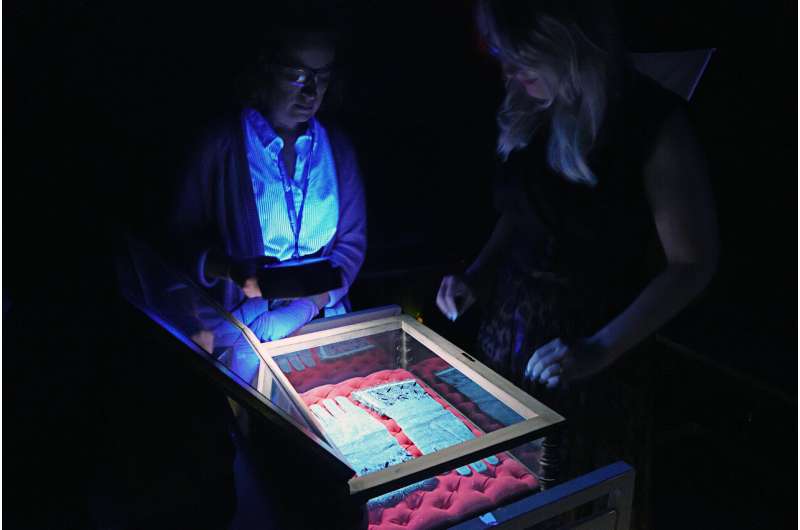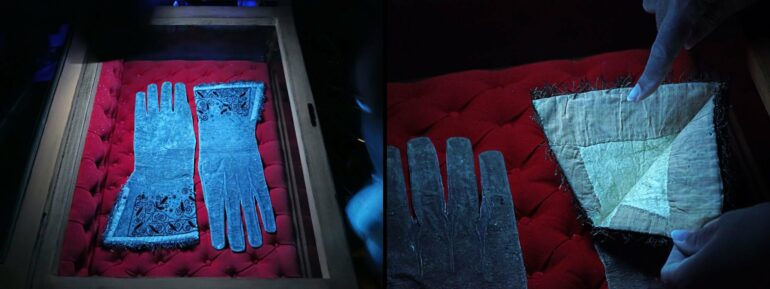The leather gloves, embroidered at the wrists, rest on a tufted pillow of red satin in a glassed wooden box, a fitting place for artifacts that have a history tied to the English-speaking world’s most-famous playwright.
Stories passed down through the centuries tell the tale that the gloves could perhaps have belonged to William Shakespeare, or at the very least to have been worn by famous Shakespearean actors hundreds of years ago. They are part of the extensive Shakespeare collection at the Penn Libraries.
While preparing materials for a visit by students in a Penn English Department Shakespeare course, Alicia Meyer, curator of research services in the Kislak Center for Special Collections, Rare Books, and Manuscripts, included the gloves.
“We had the gloves out for fun. I was sitting there looking at them, and I thought, ‘That’s fairly strange that those gloves are here, and we should try to learn more about them,'” Meyer says.
In researching the gloves during the past several months, she says “it seems like there’s always a recurring interest in them and stories around them. Each time the story shifts just a little bit.” So, she decided to enlist the help of library conservators.
“Our suspicion was that this was a mythology created around the gloves, that they belonged to Shakespeare. It’s impossible to prove who they belonged to, but one of the things I thought we could maybe do was figure out if they were from the time period,” she says.
“We could do a typical historical analysis, which I did by comparing our gloves to other gloves around the world from that time period and by just doing a simple visual analysis,” Meyer says. “And we also tested them in the conservation lab to see what they were made of and see if there were any traces of modern materials, things like adhesives or paints or any kind of things that could only exist in an industrial environment.”
Shakespeare at Penn
Penn Libraries holds one of the world’s largest Shakespeare collections, housed in the Horace Howard Furness Memorial Library and the Edwin Forrest Library, devoted to the study of Shakespeare and other dramatists. The collections include writings about Shakespeare and virtually all English-language editions of his plays and poems, including the first four folios, many early quartos, and translations into many world languages.
Meyer knows the collection well, as she earned her a Ph.D. in English from Penn in 2022. Before joining the Libraries earlier this year, Meyer was a fellow at the Folger Shakespeare Library in Washington, D.C., and a Dean’s Postdoctoral Fellow in Teaching Excellence at Penn, working with the English Department and the Program in Gender, Sexuality, and Women’s Studies.
Meyer concentrated on early modern literature during her doctoral studies. Her dissertation was on the history of women in prisons during the time of Shakespeare (1564–1616), looking at how those female characters were depicted in literature.
One of her professors was Shakespearean scholar Zachary Lesser, the Edward W. Kane Professor of English. It was for his course Slow-Reading Shakespeare that Meyer pulled out the gloves.
“I have brought the gloves out for classes to illustrate the development of this kind of worship of Shakespeare and the idea that it’s almost like a religious relic,” Lesser says.
Among the other objects related to Shakespeare in the Libraries is a box supposedly made from the mulberry tree in front of his home and a vial with a piece of wood supposedly from the room where he was born, Lesser says. None of those connections can be proven, he says.

Gadomski and Meyer examining the gloves with ultraviolet light. © University of Pennsylvania
The backstory
Gloves may have been very important to Shakespeare, Meyer says, because his father was a glover. “Gloves had great significance in the period for social status,” she says. “And they may have been used as a costume on the stage.”
David Garrick (1717–1779), a famous 18th-century actor, reportedly got the gloves from Shakespeare’s descendants, a gift bestowed to him in 1769 by the mayor at Stratford-Upon-Avon, the playwright’s birthplace in England, in honor of the actor’s work portraying Shakespeare characters. Lesser says Garrick was the greatest Shakespearean actor of that century and the person responsible for creating the city as a tourist destination.
Garrick passed the gloves on to the Kemble family of British-born actors, eventually coming to Frances (Fanny) Kemble (1809–1893), an actress also well-known as an abolitionist, who performed in Philadelphia and eventually married and settled here. “Whether or not they’re Shakespeare’s, I actually think the later history of the gloves makes them important,” Lesser says. “These are the greatest Shakespeare actors of all time.”
Kemble gave the gloves to Horace Howard Furness (1833–1912), a recognized Shakespearean scholar and the son of a prominent abolitionist. His brother, Frank Furness, the architect who designed Penn’s Fisher Fine Arts Library, created the ornate box for the gloves.
H.H. Furness Jr. (1865–1930) was on Penn’s Board of Trustees and ensured that the gloves and his father’s library and collection of Shakespeareana were donated to the Libraries. “The gloves are not on display, but they can be brought out on request, like a book or any other object,” Meyer says.
As reported in The Philadelphia Inquirer and The Daily Pennsylvanian, the British-born Shakespearean actor Maurice Evans came to Penn’s campus in 1937 to view the gloves and the Shakespeare folios.
“He put the gloves on, and the curators told him that anyone who wears those gloves will die within a year. And he immediately takes them off,” Meyer says. “And so, I was wondering, did they make that up at the time, or does that curse go back farther? And I haven’t quite answered that part of the question yet, but it was just an added element of excitement that got repeated a lot and then was in the press about the gloves.”
Evans lived until he was 87, thus casting doubt upon that particular theory.
Scientific analysis
An analysis in the Libraries’ Steven Miller Conservation Lab couldn’t address the curse, but other aspects could be investigated.
Tessa Gadomski, conservation librarian, took on the challenge. Her expertise is conservation of books and paper and photos, not gloves, she says, but there are some common materials. “There’s a lot of leather in books and a lot of sewing. So, in some ways those are material components that you can find in books, just in a different shape,” she says.
Calling it a “preliminary investigation,” Gadomski says her goal was to answer questions about the materials. “If these have been repaired or made of something that was very obviously from the 20th century or post-industrial era, we might have been able to detect that,” she says.

The XRF scan produces a computer analysis that shows the elements included in the gloves. © University of Pennsylvania
The analysis involved two techniques, one using ultraviolet (UV) light and the other X-ray fluorescence (XRF). She first looked at the gloves under a microscope, and then under UV light. The embroidered components “were completely dark and black” confirming that the embroidery incorporated metals, Gadomski says.
For the other analysis, she used the XRF technique, which uses X rays to determine the elemental composition of materials. “We were able to take a closer look at the embroidery and were able to tell there’s gold and silver,” Gadomski says. “It doesn’t answer a lot of big-picture questions in terms of what Alicia is trying to investigate because silver and gold can be from a lot of time periods. But it does help to narrow some things down and give us a little bit more context.”
Gadomski also examined the leather. “We know from the history of leather creation that there were certain tanning agents that were used in the post-industrial era,” Gadomski says, including chromium or titanium. “But we didn’t see anything like that. The main things that we found in the leather were calcium and iron. We did not see anything that we know is distinctly post-industrial.”
The analysis feeds into a computer and produces a readout expressed in graphs. “I would say that nothing really jumps out to me as a red flag in terms of there being contemporary materials,” Gadomski says. “It’s information that we didn’t have before.”
There’s some staining on the inside and evidence of minor repairs that suggest the gloves were most likely worn, although not worn a lot, she says. Future research could include DNA testing to determine what species of animal the leather is made from, she says. Her guess is sheep, based on the appearance, grain pattern, and provenance from England where sheepskin was commonly used for leather.
The results
“Even if they don’t go back to Shakespeare, Alicia’s found that they at least are plausibly 17th century gloves,” says Lesser, who doubts they were Shakespeare’s. The years between his death in 1616 and the presentation of the gloves to Garrick in 1769 are not documented, at least not yet. “It’s a long time when no one would have been interested in keeping Shakespeare’s gloves,” he says.
And what does Meyer think of the results? “I think that they’re really 17th-century gloves. To me, visually, scientifically, they seem to be early- to mid-17th century, just overlapping with Shakespeare’s lifetime,” Meyer says. “So, the story lives on.” She is writing a detailed account of her research and analysis for the Libraries’ “Unique at Penn” blog.
Shakespearean scholars say that no objects that survive from Shakespeare’s lifetime can be confirmed to have belonged to him, Meyer says.
“We can’t confirm it, but we also don’t have any reason to completely dismiss it out of hand. I think because of that there is enough room that, if you want to believe this, you can,” Meyer says. “There’s no evidence to completely denounce it that I have found, but I’m open to that possibility.”
Meyers continues to research and write about Shakespeare. “This is a great way for me to think about the movement of Shakespearean texts and why Shakespeare matters over time. Because when you trace the gloves you trace them through all of these different people and political situations and material situations all the way up to the present on this campus,” Meyers says.
“So, they’re really a great portal into history,” she says. “When you teach a class, that’s always what you want. So, it’s been really, really gratifying for that reason.”
Provided by
University of Pennsylvania
Citation:
Exploring the authenticity of a pair of storied gloves rumored to belong to Shakespeare (2024, October 22)



